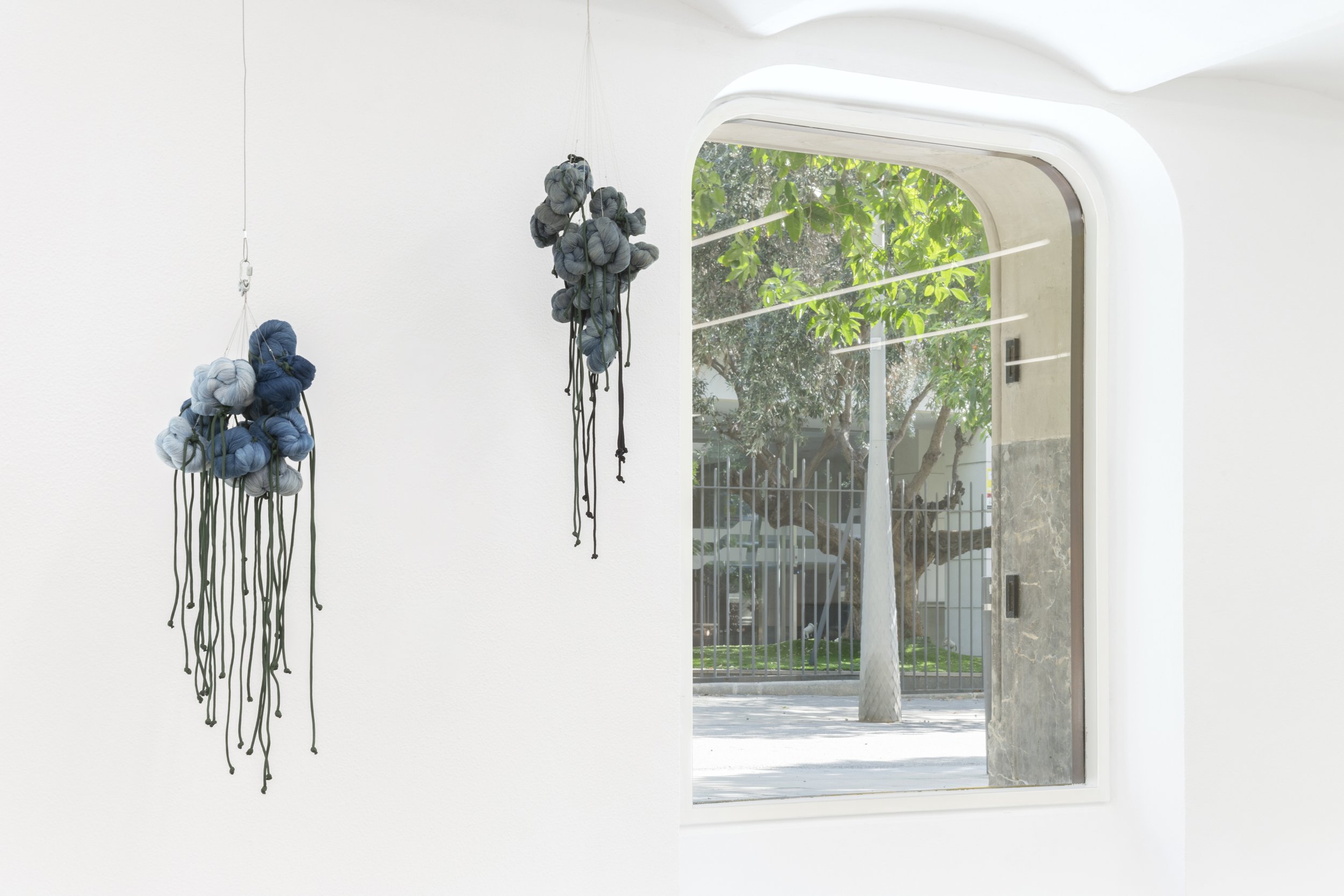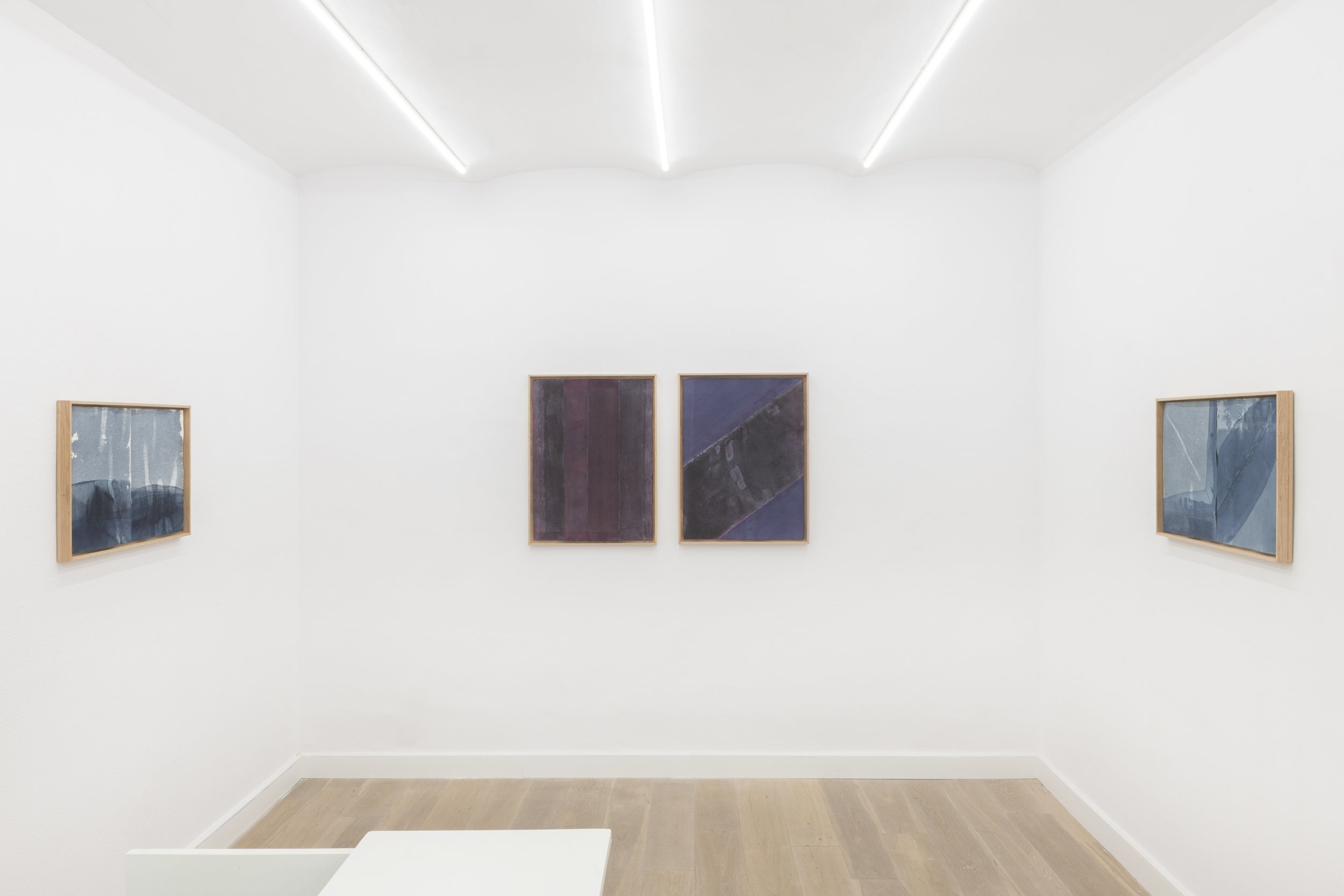Zielinsky Barcelona is pleased to present “La herida, la venda, la cura” [The wound, the bandage, the cure] a solo exhibition by Sandra Monterroso (1974, Guatemala City) within the framework of the Barcelona Gallery Weekend. Monterroso has developed an artistic practice in which she commits to restore her cultural and ancestral heritage as a Mayan artist. Her research raises awareness both of the current political reality and of the history of violence in Guatemala –racial, social and gender–, as well as of the power structures inherited from colonialism, from a situated knowledge, “heal colonial wounds through art, Mayan rituals, and the rituals of other cultures”.
For her first exhibition in Barcelona, Monterroso presents the sculptures “Expoliada No. 6”(2023), “Mujer ofrendando hilo y concha” (2023), “Puntos en Resistencia Azul” (2019) and the videos “Mac/Culpa” (2006) and “Ofrenda para Chaac” (2016), as well as the series of paintings “Composiciones Acuaticas” and “La herida, la venda, la cura” (2023), which give the exhibition its title.
Each of the sculptures present in the exhibition have been dyed with natural dyes that are responsible for creating the tones and the chromatic range: the red comes from the cochineal (Dactylopius coccus), the yellow from turmeric (Curcuma longa) and the indigofera blue (Indigofera guatemalensis). The works in this series address in a political and social manner the cultural, economic and territorial dispossession to which indigenous peoples are subjected as a consequence of the implementation of hegemonic activities in the region, whose natural resources played a central role in the expansion of a new global order of exploitation.
The sculpture “Expoliada No. 6” is made up of three suspended rows of sheep wool threads that were braided by weavers from Momostenango (Guatemala) of the COPITEM cooperative and dyed with cochineal from Oaxaca in the artist’s workshop, the shape suggests a waterfall, an element that appears other times during the exhibition tour. Using the same dyeing technique, but now mixing cochineal with indigofera, the artist exhibits two paintings from the series “La herida, la venda, la cura” [The Wound, the Bandage, the Cure], in which she paints on a cotton mesh commonly used to heal wounds during the healing process.
The sculpture “Mujer ofrendando hilo y concha” [Woman offering thread and shell] has been developed by Monterroso with fragments of a yarn mat dyed with turmeric, shell, fabric assembled, sewn and glued to form a woman who is offering different types of yarn and natural fibers. It is an offering to the nahual B’atz’, which in Mayan cosmology is the symbol of time, of all arts, fabrics and artists. In the pieces “Points in Blue Resistance”, the artist dyed the threads Indigófera guatemalensis blue, a color that was recognized by archaeological research as Mayan blue. Shades of blue range from deep indigo to variations of turquoise. In the action performed in the video “Ofrenda para Chaac” [Offering to Chaac], a ritual associated with Chaac (Mayan god of rain) is observed. The artist performs a ritual while dyeing the threads to thank the water with the fusion of precious elements and properties. healing: indigo and copal.
In the video “Mac/Culpa” [Mac/Guilty], the action of breaking clay pots is a ritual to heal the spirit within the Q’eqchi’ culture, the pots are broken, people cry and the Xmuhel (spirit) is invoked. On the other hand, the action of destroying clay pots questions the barbarism of the unjust culture in daily life since to have water, you have to carry it, an action that is almost always carried out by women. A woman is liberated and becomes aware of herself through the violent game of collapse: the clay pots are transformed, absolved as objects of use. The longer vessels of everyday life, which are no longer captives of themselves, are freed from their object content, they return to dust in order to be redefined again.
This solo exhibition at Zielinsky coincides with the group exhibition “ReVisión: Art in the Americas” at Minneapolis Institute of Art, USA, where Monterroso presents the video “Tus tortillas mi amor (Lix Cua Rahro)”(2014). The exhibition, curated by Victoria Lyall & Valeria Picolli, tells the story of the formation of the American continent through a visually captivating narrative spanning from 100 BC. C. until today.
Sandra Monterroso (1974, Guatemala City) began her artistic career in performance art in 1999. She earned a B.A. in Graphic Design in 2001 followed by an M.A. in Design from Universidad Popular Autónoma del Estado de Puebla (UPAEP) in Puebla, Mexico. In 2020, Monterroso earned a PhD in Art Practice from the Akademie der bildenden Künste Wien in Vienna, Austria. She has represented Guatemala in more than twelve biennials, including the 56th La Biennale di Venezia (Indigenous Voices – Padiglione Latin America), the 12 Bienal de La Habana, and the Frestas - Trienal de Artes in São Paulo. Selected exhibitions include The Getty Center, Los Angeles, USA; Fundação Calouste Gulbenkian, Portugal; Center Pompidou, France; Denver Art Museum, USA; UNAM Lake House, Mexico City, Mexico. Selected collections include: Museo Nacional Centro de Arte Reina Sofía, Spain; Essex Collection of Latin American Art, Colchester, England; Yes Contemporary Collection, Miami; Paiz Foundation Collection for art and culture, Guatemala; Centro de Arte Fundación Ortiz-Gurdián, Managua, Nicaragua; Museo de Arte y Diseño Contemporáneo (MADC) de Costa Rica, San José, Costa Rica. Monterroso lives and works in Guatemala City.


























